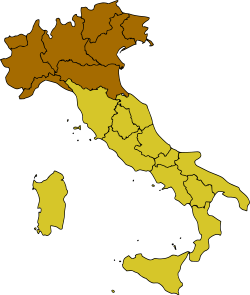
Back شمال إيطاليا Arabic Italia septentrional AST Obaitalien BAR Паўночная Італія Byelorussian Северна Италия Bulgarian Severní Itálie Czech Norditalien Danish Oberitalien German İtalyay Zımey DIQ Norda Italio Esperanto
Northern Italy
| |
|---|---|
 | |
| Country | Italy |
| Regions | |
| Area | |
| • Total | 120,260 km2 (46,430 sq mi) |
| Population | |
| • Estimate (2020 est.) | 27,437,474 |
| Languages | |
| – Official language | Italian |
| – Official linguistic minorities[2] | |
| – Regional languages | |
Northern Italy (Italian: Italia settentrionale, Nord Italia, Alta Italia) is a geographical and cultural region in the northern part of Italy.[3][4] The Italian National Institute of Statistics defines the region as encompassing the four northwestern regions of Piedmont, Aosta Valley, Liguria and Lombardy in addition to the four northeastern regions of Trentino-Alto Adige, Veneto, Friuli-Venezia Giulia and Emilia-Romagna.[5]
With a total area of 120,311 km2 (46,452 sq mi), and a population of 27.4 million as of 2022, the region covers roughly 40% of the Italian Republic and contains 46% of its population.[5] Two of Italy's largest metropolitan areas, Milan and Turin, are located in the region. Northern Italy's GDP was estimated at €1 trillion in 2021, accounting for 56.5% of the Italian economy.[6]
Northern Italy has a rich and distinct culture.[7] Thirty-seven of the fifty-nine World Heritage Sites in Italy are found in the region. Rhaeto-Romance and Gallo-Italic languages are spoken in the region, as opposed to the Italo-Dalmatian languages spoken in the rest of Italy. The Venetian language is sometimes considered to be part of the Italo-Dalmatian languages, but some major publications such as Ethnologue (to which UNESCO refers on its page about endangered languages) and Glottolog define it as Gallo-Italic.[8][9]
- ^ "Statistiche demografiche ISTAT". www.demo.istat.it. Archived from the original on 1 October 2018. Retrieved 14 September 2017.
- ^ "Legge 482". Webcitation.org. Archived from the original on 24 September 2015. Retrieved 17 October 2015.
- ^ Castagnoli, Adriana (2004). Culture politiche e territorio in Italia: 1945–2000. Milano: Angeli. p. 34. ISBN 978-8846452337.
- ^ Mangiameli, Stelio (2012). Il regionalismo italiano tra tradizioni unitarie e processi di federalismo. Milano: Giuffrè. ISBN 978-8814174131.
- ^ a b "Italy 2022 Statistical Yearbook" (PDF) (in Italian). Italian National Institute of Statistics. p. IX. Retrieved 18 October 2023.
- ^ "Gross domestic product (GDP) at current market prices by NUTS 3 regions". Eurostat. Retrieved 18 October 2023.
- ^ Allen, Beverly; Russo, Mary (1998). Revisioning Italy: national identity and global culture. Minneapolis: University of Minnesota Press. p. 257. ISBN 978-0816627264.
- ^ "Venetian". Ethnologue.
- ^ "Glottolog 4.2.1 – Venetian". glottolog.org.